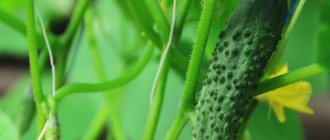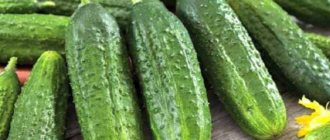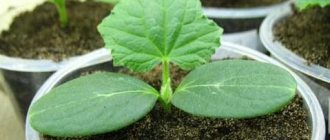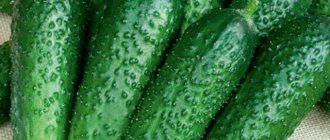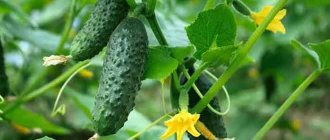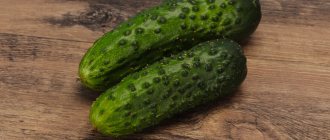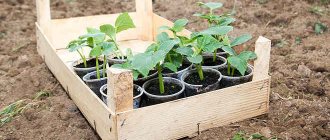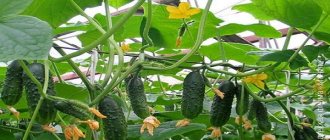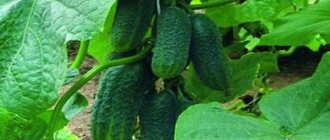Far Eastern 27 has long been known to gardeners. Despite the emergence of more productive hybrids, it does not lose popularity among summer residents who prefer tasty cucumbers that can be grown in open ground.
| Landing location | Ripening time | Mode of application | Fruit length | Group | Fruit smoothness | Pollination method |
| Open ground | Mid-early (46-55 days) | Universal | Medium - from 10 to 15 cm | Variety | Highly lumpy | Bee pollinated |
Description of cucumbers Far Eastern 27
Cucumber Far Eastern 27 is a bee-pollinated, cold-resistant variety, ideal for canning. Main characteristics of this plant:
- The bush is long-climbing, weakly leafy, branched, 1-1.3 m high.
- The leaf of the variety is large, rich green, three-lobed, with sparse whitish pubescence.
- The cucumber is a gherkin, its length is 12-14 cm, its weight is 110-135 g, its shape is an elongated barrel.
- The skin is dark green in color with thin light stripes, highly lumpy, dense.
Far Eastern 27 has juicy, aromatic, slightly sour flesh without voids or bitterness. Its yield is low - only 6 kg/m², in contrast to late cold-resistant hybrids, such as Lapland f1. To some extent, this deficiency of the variety is compensated by long fruiting - until the first long frost.
History of the development of the Dalnevostochny variety
The Far Eastern cucumber is considered one of the oldest varieties of domestic selection.
The history of the creation of culture goes back to the Second World War. In the 30s of the last century, breeder E. A. Gamayunova at the Far Eastern Research Institute, which is located in the Khabarovsk Territory, began using selection methods to improve the quality of local varieties of cucumber crops. Thus, in 1943, several subspecies of cucumber were obtained, under the names Far Eastern 27 and Far Eastern 6. In 1950, these crops, having passed all the test work, were included in the State Register, after which their cultivation began in the Khabarovsk and Primorsky Territories.
The antiquity of this cucumber variety is fascinating - it was obtained back in the 30s of the 20th century at the Far Eastern Research Institute of Agriculture using the method of selection from the population of the folk selection variety Far Eastern Local.
And since 1941 they have been in the collection of VIR. From the same population, at one time, such varieties of cucumbers were also created as:
- Vanguard;
- Far Eastern 6;
- Vladivostoksky 155.
In 1943, an application for registration was submitted to the State Register of Breeding Achievements, and in 1950 the cucumber variety Dalnevostochny 27 was officially registered there. To this day, it is on the list of varieties approved for cultivation in Russia, primarily in the Far Eastern region. The author of the Far Eastern 27 cucumber is E.A. Gamayunova.
Today, the seeds of these cucumbers can be purchased in packaging from a wide variety of seed companies: Aelita, Gavrish, Sedek and others.
The Dalnevostochny 27 variety is traditionally bee-pollinated, so it is best grown in open beds in the garden. When cultivated in greenhouses, cucumber bushes will require additional attraction of insects or the use of hand pollination.
Dalnevostochny 27 is an indeterminate, vigorous cucumber variety with long-climbing and branched shoots. The leaves are medium in size and their color can vary from dark green to green. The foliage of the plants is below average, which improves lighting and makes it easier to pick cucumbers. The type of flowering is mixed, which means the likelihood of female and male flowers appearing in equal proportions.
According to the ripening period, the Dalnevostochny 27 variety can be classified as mid-season cucumbers. Fruiting begins approximately 40-55 days after emergence.
It is difficult to imagine conditions under which one might not get a harvest from the Dalnevostochny 27 variety. Since the plants of this cucumber are also resistant to lack of moisture and even to slight night frosts.
Fruiting with regular watering and fertilizing can continue until the very first frosts and snows. There are no official data on the yield of this variety, but apparently its indicators are at an average level.
According to some reports, the Dalnevostochny 27 variety is also resistant to downy and powdery mildew.
Advantages and disadvantages of the variety
The cucumber in question is ideal for difficult climatic zones. Far Eastern 27 is capable of producing crops even during frosts and short droughts. However, this is not the most prolific variety, which in unprotected soil easily becomes prey for pests.
pros
This variety can boast of qualities that are irreplaceable in the harsh conditions of the Far East. The main advantages that Far Eastern 27 demonstrates:
- cold resistance - plantings are able to grow and bear fruit even in harsh climates;
- developed immunity - cucumber almost does not suffer from bacteriosis and peronosporosis;
- drought resistance - the bushes will not dry out in dry summers, they do not require a lot of water;
- excellent taste - cucumber has a pleasant fresh taste, it does not lose density and crunch after processing;
- low maintenance requirements - even a novice vegetable grower can cultivate the plant.
Finally, the weak foliage of the variety’s bushes makes it easier to care for plantings and harvest.
Minuses
The disadvantages of Dalnevostochny 27 are typical for the northern variety. Vegetable growers point out the following disadvantages:
- low yield - you can’t get more than 5-6 kg per 1 m² even under film.
- branching - the cucumber grows quickly, its growth must be carefully controlled;
- tendency to overgrow - greens that are not picked in time turn yellow and become tough.
In addition, in warmer climates, Far Eastern 27 is often attacked by parasitic insects. This variety does not feel very comfortable in a greenhouse; it needs space and fresh air.
Soil and fertilizers
Cucumbers need warm, fertile soil with a pH between 6.0 and 6.8, although they can grow in slightly more alkaline soil (pH as low as 7.6). To improve the soil and help create a good environment for roots, necessary for a large harvest, you need to add rotted compost to the root layer of the soil and dig up the bed with a rotation of the layer.
It will be useful for you to read about what types of soils exist, how to increase soil fertility, how to independently determine the acidity of the soil on your site, as well.
You can also prepare a bed for cucumbers in advance and fertilize it with manure:
- To do this, remove the top layer of soil (20-30 cm) at the site of future planting of cucumbers.
- Last year's vegetable debris from the garden (leaves, small sticks) is placed in the resulting trench. This layer will serve as drainage for the cucumber roots.
- The second layer (on top of plant debris) is laid with cattle manure. Lay a layer 10-20 cm thick.
- The third layer is laid with the earth previously removed from the trench.
- Cucumbers are very fond of such “sandwich” beds and bear fruit well on them.
What they like:
- Cucumbers love warm, moist, loose, well-fertilized soil and sunlight (well-lit places).
- The beds should be well drained.
- Adding compost to the soil will help your cucumbers grow quickly, and applying organic fertilizers such as manure will give the plants nutrients as they grow.
- Cucumbers can be planted in raised or regular beds.
- Since cucumbers are a climbing plant, they take up a lot of space when growing.
- It is most convenient to grow cucumbers on trellises. They are easy to care for, easy to harvest, the cucumbers do not come into contact with the ground and do not get dirty.
Important! It is not advisable to plant cucumbers after their predecessor, cucumber or pumpkin crops. Disease spores and overwintering pests may remain in the soil after a related crop.
Landing Features
The variety was developed mainly for cultivation in the Far East and Siberia. Far Eastern 27 is able to grow in almost any soil, except for heavy clay, acidic and swampy ones. Cucumber feels best in sandy loam and chernozem soil.
Site preparation
Preparation of land for Far Eastern 27 begins in September. The soil is dug up to a depth of 50-55 cm, disinfected with Trichodermin and fertilized with mullein solution. The second stage of soil preparation for the variety is 3-4 days before planting.
The area for the cucumber is weeded, removing the roots and insects that have overwintered in the soil, then loosened and fed with rotted sawdust or wood ash. In dry springs, the soil is additionally moistened before planting.
Germination of seeds
Far Eastern 27 is planted for seedlings in mid-April. To minimize the risk of re-grading, it is better to use seed material that is three to four years old. Seeds are added to separate peat containers, 1-2 pieces each. in a pot. The cucumber is buried 1-1.5 cm.
The air temperature is maintained at 22°-23°. Water the sprouts every other day, preferably in the evening. A week after the variety sprouts, it is fertilized with wood ash.
A week before planting, they begin to harden the cucumber in the fresh air, increasing the time of “walks” daily by 10 minutes.
Planting seedlings
Seedlings of the Dalnevostochny 27 variety are transferred to the soil at a height of 15-20 cm, on days 27-28 after seeding. This happens in mid-May. Plant the sprouts in loose, well-moistened soil. The distance between bushes is 40 cm, the recommended row spacing for cucumbers is 70-75 cm.
The maximum number of bushes per 1 m² is 3, and you need to ensure that the plantings do not thicken and that Far Eastern 27 receives enough light and oxygen. Immediately after planting, the cucumber is watered and hilled, covering the bushes with soil up to half their height.
Growing technology
The variety has gained popularity throughout Russia. Cucumbers are grown both in the south and in the middle zone. Popular in areas of risky farming.
Note!
It can easily tolerate unfavorable conditions, so it is suitable for growing in open ground in the middle zone.
It is recommended to use the seedling method. It allows you to speed up the ripening of the crop:
- About a month before planting in the ground, sow the seeds in pots.
- You can place 1-2 seeds in one container.
- They must be placed at a depth of 2 centimeters.
- They can be germinated both at home and in greenhouse conditions.
- Recommended temperature 27 degrees.
To grow in the open ground of the Far East, choose soil with a high content of nutrients. The soil must have good aeration properties.
As soon as the first shoots appear, the temperature should be lowered. The recommended value is 22 degrees. To avoid stretching the seedlings, you can add additional light. Seedlings can be fed with mineral and natural fertilizers. The use of complex formulations is recommended. If seedlings are grown on a windowsill, then they need to receive:
- potassium;
- nitrogen;
- phosphorus.
The application of liquid fertilizers to seedlings consists of two main stages:
- when leaves appear on the seedlings, the need for fertilizer is determined by the fact that the plant enters the phase of active photosynthesis;
- a few days before planting seedlings, it allows the plant to receive nutrients that will help it successfully go through the adaptation period in a new place.
When the sprouts have reached a height of 15 centimeters, they can be planted. In this case, the temperature should be 15-20 degrees. The ideal time for planting seedlings is early May.
Cucumbers of this variety need to be grown using the trellis method. The “spread out” method should be used only if the planting is carried out in a hilly area. Under such conditions, one square meter is an area sufficient to plant 5 plants.
Note!
When using the trellis method, plant formation is standard. Free the four lower nodes from leaves and inflorescences. Pin the main stem together with the shoots of the first order. Give second-order shoots freedom to grow.
Cucumbers need to be planted in holes. The distance between them should be 35 centimeters. If you plan to grow cucumbers in a greenhouse, then using the seedling method is not required. The width of the beds in the greenhouse should be 60 centimeters. They need to be placed at a distance of a meter from each other.
Care
The cucumber in question is not at all difficult to care for. Far Eastern 27 needs frequent but superficial loosening, regular weeding, watering, periodic fertilizers and protection from pests. Of particular importance for the variety is the correct formation of branched bushes.
Watering
This variety does not require a lot of moisture, however, due to insufficient watering, the greens begin to taste bitter. With regular precipitation, Far Eastern 27 will require watering once every 3 days. The volume required by the variety is 12-15 liters. on the bush. In dry summers, liquid is added every other day. The cucumber is watered late in the evening and only with warm, settled water. The watering method is drip, at the root, but in hot weather the leaves are additionally sprayed with a spray bottle in the early morning.
Garter and bush formation
Due to its high climbing habit, Far Eastern 27 requires a special approach to the shape of the bush. Plant varieties are formed as follows:
- With a height of 25-30 cm, the cucumber is tied on vertical trellises; in a greenhouse and greenhouse, it is additionally secured on top with wire.
- At a height of 0.9-1 m, the top of the bush is pinched.
- The side branches of the first level are left 45-50 cm long, the second level - 15-20 cm.
- All other shoots are removed - this procedure is done 2-3 times a season.
In the greenhouse, the cucumber is blinded up to the 3rd leaf. Barren flowers from the Dalnevostochny 27 bush are not cut off, as they participate in pollination.
Top dressing
This cucumber loves organic and potassium-phosphorus fertilizers. They feed Far Eastern 27 every 10 days. The first fertilizer is a week after transplantation, using a compost solution or humus. The second time the seedlings of the variety are fed at the beginning of flowering - this can be superphosphate or potassium sulfate. The last time a solution of nitroammiaphosphate and chicken manure is applied under the bushes of the variety is during the period of formation of the ovaries.
How to grow your own
Temp F1 is intended for greenhouse soil. It is undemanding in terms of living conditions and care, so its agricultural technology does not present any difficulties.
Planting seeds and seedlings
Cultivation of the hybrid begins by obtaining seedlings or sowing directly into greenhouse soil.
Seeds
Seeds are planted in central Russia in late May–early June, depending on weather conditions. The crop grows and develops at soil temperatures of +16...+18 °C.
Scheme of planting in a greenhouse for the seed method:
| Seed depth indicator | 3–3.5 cm | |
| Distance between | in rows | 60–70 cm |
| bushes | 10–15 cm |
Sowing technology:
- They dig up the soil to a depth of 10 cm. If the greenhouse has formed raised beds in boxes, the soil is replaced with fresh soil. The hybrid likes soil made from turf, peat and humus. They are combined in a 1:1:1 ratio, after which 250 g of ash and 25 g of superphosphate are added per bucket of the mixture.
- Form furrows 3 cm deep in the garden bed and water them generously with warm, settled water.
- Plant the seeds, cover with soil, mulch with a layer of peat no more than 2 cm thick.
Before the emergence of seedlings, the ground is periodically moistened with a spray bottle or watering can with a diffuser, so as not to wash away the plantings.
Seedlings
The seedling method allows you to get the first harvest 1-2 weeks earlier. The seeds are planted in boxes filled with moistened soil, and after 1–1.5 months the grown bushes are moved to the greenhouse.
Seedling care includes:
- Water as the soil dries with warm (+20…+25 °C) settled water.
- Maintaining the temperature during the day at +18...+22 °C, at night - +18 °C.
- 2 weeks before transplanting, feed the plants with a solution of 10 g of potassium sulfate, 15 g of superphosphate and 5 liters of water. The product is poured at the root.
- 7–10 days before picking, hardening the seedlings: they are placed in a room with an air temperature of +12…+15 °C for 2-3 hours a day.
A healthy crop, ready for transplanting into indoor soil, should have a thick, developed stem, short internodes and rich green leaves. In the beds, make holes with a diameter 2-3 cm larger than the root system, water them abundantly, move the bushes into them, add in drops of light soil and lightly compact them to give the plants stability.
Growing in stages and care
Rules for growing and caring for cucumbers Temp in greenhouses:
- The lashes should not spread along the ground; to do this, they are carefully tied up, without squeezing, so as not to disrupt the circulation of juices.
- Water with warm, settled water, avoiding waterlogging and drying out of the soil.
- The soil is loosened once every 10–14 days so that a crust does not form on its surface, which will interfere with the penetration of moisture and air to the root system.
- Weeds are removed as they appear.
- To feed cucumbers, organic and mineral fertilizers are used, alternating them.
- After the bushes reach a height of 2 m, they are pinched. In case of strong thickening, remove excess side shoots and leaves.
Features of cultivation and possible difficulties
When cultivating a hybrid, gardeners face some problems:
| Description of the problem | Causes | Solution |
| The fruits take on an ugly shape and look more like pears than cucumbers | Potassium deficiency | 1 tbsp. dissolve ash in a bucket of water, leave for 24 hours and use for watering (1 liter of solution/bush) |
| Plants develop poorly, foliage turns yellow and dries out | Nitrogen deficiency | 4 tsp. Dilute nitrophoska in 5 liters of water, add 200–300 ml of product under each lash |
| No ovaries |
| Ventilate the greenhouse more often and do not apply fertilizers containing nitrogen. |
| Wilting cucumbers | Waterlogging or drying out of the soil | Bring the watering regime back to normal |
| Small holes appear on the leaves | Burns from direct sunlight | Shade the plantings by covering the greenhouse with transparent material |
Diseases and pests
The hybrid is resistant to cladosporiosis, downy and powdery mildew, mosaic, and therefore does not need any protection. With high humidity, aphids may appear in the greenhouse, but the crop is not sensitive to such pests.
As a preventative measure, some gardeners spray cucumbers with folk remedies prepared according to the following recipes:
- 500 g of ash and 50 g of laundry soap shavings per bucket of water.
- Pass the head of garlic together with the husk through a meat grinder, pour in 5 liters of hot water, leave for 24 hours. Then strain.
- Cut 4 small pods of hot pepper into thin rings, add to 5 liters of water and leave for 2 days.
Diseases and parasites
Far Eastern 27 has a high complex immunity and gets sick quite rarely. However, in dense soils, such a cucumber can be affected by rot, and in warm climates in open ground, it can be eaten by parasitic insects. If the bushes grow in a greenhouse - its walls must be treated with formaldehyde every 10 days - this will save Far Eastern 27 from fungal diseases.
Root rot
Rot can infect cucumbers with excessive and cold watering. You can recognize the onset of fear by the putrefactive brownish ulcers on the root part of the stem. Far Eastern 27 is treated for rot by dusting the affected stems with chalk and coal powder (or wood ash). The best prevention is to spray the plantings of the variety once every 2 weeks with Previkur.
Spider mite
The parasite attacks Far Eastern 27 at high humidity. You can notice the appearance of a mite by the sticky thin web on the back of the leaf. Treatment with Vermitek or Fufanon will help rid the cucumber of the pest. To scare away ticks from planting varieties, marigolds, onions, wormwood, or yarrow are planted around the area - these plants emit an unpleasant odor for ticks.
Aphid
The small pest feeds on the juice from the leaves of the variety. Prevention against the parasite is carried out before planting by planting dill along the perimeter of the site under the Far Eastern 27 - it attracts ladybugs that eat aphids. If the parasite does get on the cucumber, the bushes are treated with a strong garlic infusion.
How to choose and prepare seeds correctly
Seeds for growing seedlings are purchased in specialized stores or obtained independently from previous harvests.
Purchased planting material does not require additional preparation. Seeds collected independently before planting undergo special treatment. Seeds stored from the previous harvest are sorted out, removing spoiled, rotten or cracked specimens.
The remaining seeds are poured with a water-salt solution. Seed material unsuitable for planting floats to the surface, good seeds settle to the bottom of the container. Seeds suitable for planting are sent to warm up for 1.5-2 hours in an oven preheated to +50-60 degrees. Next, the seeds are treated with a solution of manganese and a growth stimulator.
Expert opinion
Stanislav Pavlovich
A gardener with 17 years of experience and our expert See also: Measures to combat spider mites on cucumbers in open ground and greenhouses
Ask a Question
Advice! To quickly obtain seedlings, the seed is wrapped in a wet cloth and sent to a warm place. After a couple of days, the seeds germinate.
Sowing rules
Growing cucumber varieties depends on the climatic conditions of the region. If the temperature allows, the seeds can be planted in open ground.
But most gardeners prefer the seedling method. Seeds are sown in small planting boxes. The embedment depth is two centimeters. After three to four days, you can observe the appearance of the first shoots.
Sowing of seedlings is carried out in early April. Seedlings that have reached fifteen to twenty centimeters in height are allowed to be transferred to a permanent place. In most cases, this period occurs at the beginning of May.
Harvesting and storage rules
It is believed that cucumbers grow only at night. Having warmed up under the sun's rays and absorbed a sufficient amount of moisture, vegetables actively develop at night.
Picking cucumbers should be done twice a week
Fruiting continues until those days when the temperature at night drops below fifteen degrees Celsius. But as soon as the weather returns, the crop begins to produce again.
Green plants should be harvested twice a week as they grow. If you ignore this event, the cucumbers will overgrow and turn yellow.
The plant is recommended for cultivation even by beginning gardeners. With minimal care, the cucumber crop is able to bear fruit without requiring increased care requirements. It should be added that when growing, it is necessary to form bushes by pinching the main shoot and first-order shoots after the fourth leaf.
